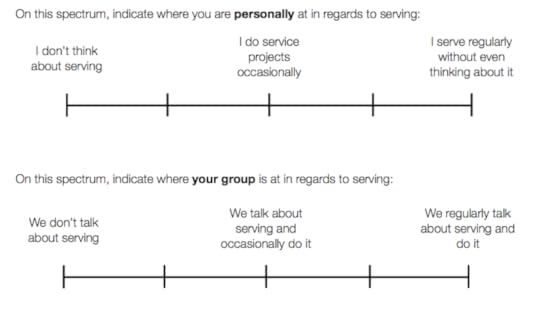Daniel Im's Blog, page 23
August 9, 2016
David Isn’t a Role Model

Not everyone in the Bible is a role model. For example, who looks at Goliath and says, “I sure want to be like him when I grow up!”
However, how many times do we look up to David and try to emulate our lives after his? After all, he was the King of Israel, the greatest poet of all time, and the author of the psalms–including the famous Psalm 23, “The Lord is my shepherd, I shall not want…”
Now there are many honorable things in David’s life that we can learn from, but unfortunately, he doesn’t teach us morality. He’s the one who committed adultery, killed a man to cover up his tracks, and lied to get his way.
The fact is, David doesn’t teach us morality, he teaches us how to be human.
He teaches us how to be real and he teaches us how to have a close, intimate, and living relationship with our Lord God.
The post David Isn’t a Role Model appeared first on Daniel Im.

August 2, 2016
Leadership Development According to Dietrich Bonhoeffer
*My post here was originally published on July 12, 2016 in Christianity Today.

Does your church have an intentional development plan to disciple and deploy believers to live out the Great Commission? Are you providing strategic pathways and opportunities for your congregation to participate in church planting so that they can be a part of the Kingdom of God invading into every crevice of society both locally and globally? Or, does this happen haphazardly when someone approaches you and they say that they feel called to ministry?
Jesus said to His disciples, “The harvest is abundant, but the workers are few. Therefore, pray to the Lord of the harvest to send out workers into His harvest.” (Matthew 9:37-38 HCSB)
All Are Called
When I look at those verses, I see them as a call to pray for more harvest workers. But as a pastor and as a church leader, I also see them as a call to disciple my congregation into being harvest workers for the harvest that exists around them both locally and globally.
As a result, while a once-a-year sermon that challenges your congregation to consider full-time ministry may be helpful, it can actually create more harm than good. This sort of sermon unintentionally creates a culture that says some are called and others are not. But the reality is that all believers have the same primary calling—to go and make disciples of all nations. What we do to earn money is a secondary issue, not a primary one!
Instead of merely hoping that your preaching will stir some to see their primary vocation and calling as being harvest workers, what if you actually created intentional environments and training opportunities to call people into this reality? What if everyone in your church saw their primary vocation as being a harvest worker, where some would get a paycheck from the church if their role was to be an equipper of others (Ephesians 4:11-13), and others would get their paycheck from an employer, while serving passionately on the worship team, children’s ministry, or leading a small group? Then we would definitely see more churches get planted.
Dietrich Bonhoeffer
In Eric Metaxas’ epic biography of the pastor, martyr, prophet, and spy, Dietrich Bonhoeffer, we read about the ways that Bonhoeffer trained people for the call of ministry. Although, as the first head of the seminary in the Confessing Church, he was focusing on training individuals for full-time pastorates, there is much that we can glean from his methods that relate to our discussion at hand—training all people to embrace their first and foremost vocation as a harvest worker.
Before we get to those points, here’s a bit of background to understand why Bonhoeffer was starting a new seminary. The main reason Bonhoeffer moved back to Berlin to run the Confessing Church seminary was due to the fact that German Church seminaries had gone apostate. The German Church was compromising on theology and allowing itself to be shaped and formed by Hitler’s anti-Semitism. This was also at a time in history when the savage bloodbath known as the Night of the Long Knives had just occurred. As a result, Hitler was quickly gaining power while the divide between the German Christian Church and the Confessing Church continued to rapidly widen.
When it comes to creating intentional environments and training opportunities to encourage people to embrace their first and foremost calling as harvest workers, here are three things that we can learn from the way that Bonhoeffer designed and ran this seminary.
1. Disciples before Ministers
Bonhoeffer was deeply inspired by the Sermon on the Mount and he believed that Christianity would look and be radically different if believers would just merely live it out. So he called his students to see themselves, not as theological students, but as disciples intentionally living out the Sermon on the Mount. “Bonhoeffer was interested in a Holy Spirit-led course adjustment that hardly signaled something new” (Metaxas, Bonhoeffer, 263).
Since theological education in his day produced “out-of-touch theologians and clerics whose ability to live the Christian life—and to help others live that life—was not much in evidence,” Bonhoeffer wanted to train an army of harvest workers who were first disciples before they were ministers (Metaxas, Bonhoeffer, 263).
2. Close, Not Afar
Metaxas, the biographer, recounts a time when a new student, Bethge, was getting to know the rest of the students on the beach. After asking the other students where the Director was, Bethge was genuinely surprised when they pointed out Bonhoeffer to him because he was athletic, young, and playing soccer with the others. “When Bonhoeffer finally realized that another ordinand had arrived, he left what he was doing, greeted Bethge, and invited him to take a walk along the beach” (Metaxas, Bonhoeffer, 264).
Bonhoeffer understood the importance of being close to his students, like Jesus was with His disciples. As a result, he made it a point to personally spend time with them, relate with them, and disciple them. In fact, Bonhoeffer refused to be called by titles that placed him on a higher ground than others. So at the seminary, he was referred to as Brother Bonhoeffer, rather than Director Bonhoeffer—this was truly counter-cultural in his day.
3. Scripture is Personal
First thing in the morning, all the students would gather around the dinner table and have a forty-five minute service together before breakfast. The service would be a mix between singing, a reading from the Old Testament, more singing, another reading from the New Testament, prayer, and the like. After the service ended and breakfast was finished, every student was required to spend half an hour meditating on a Scripture passage—students would meditate on the same verse for an entire week. “Then everybody went to his room and thought about the Scripture until he knew what it meant for him today, on that day. During this time there had to be absolute quiet…” (Metaxas, Bonhoeffer, 268).
Bonhoeffer taught his students to do this so that they would first and foremost see Scripture as God’s personal word to them, rather than as a text that needed to be preached. As a result, while the students were meditating on the passage, Bonhoeffer did not even let the students look at the verse in the original language, or consult commentaries on it!
Conclusion
In order to disciple and deploy believers to live out the Great Commission, you need to first help them distinguish between their primary and secondary callings. So…
What environments do you have to do this other than your worship service?
What would it look like for you to wrestle with and integrate these three principles from Bonhoeffer’s seminary into your discipleship groups and the life of your church?
The post Leadership Development According to Dietrich Bonhoeffer appeared first on Daniel Im.

July 26, 2016
Pastor, What Makes Your City Unique?

The type of leader who plants an urban church looks different than the one who plants a rural one.
This is a relatively unimpressive statement for obvious reasons. After all, those who would want to live on a 20 acre piece of land and raise chickens are typically not the same type of people who would want to live in an 800 square foot high rise and prune a banzai tree or a Chia pet. (Remember when that was a thing?)
This is kind of like someone who asks you if they can ask you a question, when by virtue of asking you that question, they’ve already asked you a question. Or, as the great philosopher and comedian Steve Martin said, “A day without sunshine is like, you know, night.”
What makes something obvious anyway? And who determines what constitutes as common knowledge?
Okay, before I cause you to have an existential breakdown, let me get to the point of this nonsense.
The Point
In the past few months, I’ve been traveling quite a bit talking about church planting, leadership, and discipleship. I’ve been sharing from my latest book that I co-authored with Ed Stetzer, Planting Missional Churches, as well as from the latest research we conducted on church planting and multiplication. You can download that research for free here.
As a result, I’ve had the privilege and blessing to meet with church planters and pastors in major metropolitan cities like New York, Houston, and Los Angeles. And I’ve noticed something.
The type of leader who plants a church in New York is different than the type of leader who plants in Houston or Los Angeles.
It’s not that they necessarily look different, or require distinctive theological education, but there’s definitely a difference. It’s almost…intangible.
It’s kind of like when someone asks a happily married couple how to tell if someone is the one. The answer is often, “You just know when you know.”
What Makes Cities Different?
While each of those cities may share many more similarities with one another, than with a small town in rural Kentucky, they are actually quite distinct in culture. Now I understand that in each of those cities you will find many of the same occupations, services, and systemic issues, but there’s one thing that makes each of them unique. And it’s this one thing that deeply shapes the identity, culture, and ethos of the city.
It’s the history of the city.
Not only have I noticed this while teaching and coaching different pastors and leaders in each of those cities, but this is something that I’ve also discovered after pastoring and living in six major cities in three separate countries.
The history of a city shapes the ideology, norms, issues, and nuances of perspectives, but it does so subtly. It’s hard to pinpoint these differences for someone who has lived in that city for their entire life. It’s often only when you move away and experience something different that you finally recognize the intangibles of that city that you were once unaware of.
So I want to encourage you to do two things to better grasp the unique nuances of the city that you’re living and pastoring in. By doing these two things, you will grow in your ability to minister to and pray for those in your church and your city.
Learn the history of your city and the major events that have shaped it (i.e. battles, public scandals, riots, and social issues)
Get to know pastors of other cities and visit them
What are your thoughts?
The post Pastor, What Makes Your City Unique? appeared first on Daniel Im.

July 19, 2016
Leading Change in the Church
 Conal Gallagher
Conal GallagherOne of my favorite things to do is to help churches create alignment and momentum within their staff and leadership to move their church towards multiplication. In order to do just that, change needs to happen. There’s no other way around it.
Unfortunately, most pastors and leaders struggle with change management. This is because many forget to think through who all and what all is going to be affected by this change. As a result, people are overlooked, feelings get hurt, and easy wins are lost. Inevitably this results in unnecessary conflict that could have and should have been avoided.
Your mighty plans for change are then lost in the mire of relational trouble and politics. Nothing changes. Your church stays on the same course. And the next time you try to change something, you experience even more opposition and skepticism than ever before.
If only there were an easy step-by-step process to guide people through leading and managing change in the church.
Leading Change
John Kotter’s 8-Step Process outlined in Leading Change has heavily influenced the way that I process, think through, and lead change. I’ve implemented his 8-steps through precarious times and important shifts in churches, like when I helped my previous church make the shift to becoming more missional.
Here are his 8-steps, as now updated in his recent book, Accelerate:
Step 1: Create a Sense of Urgency
Step 2: Build a Guiding Coalition
Step 3: Form a Strategic Vision and Initiatives
Step 4: Enlist a Volunteer Army
Step 5: Enable Action by Removing Barriers
Step 6: Generate Short-Term Wins
Step 7: Sustain Acceleration
Step 8: Institute Change
Leading Change in the Church
These 8-steps are a proven system for change management and they can certainly be contextualized for use in the church, which I’ve personally done, but it’s definitely not a perfect fit.
This is why I’m so excited that the President and CEO of LifeWay, Thom Rainer, wrote this book, Who Moved My Pulpit: Leading Change in the Church.
Rainer draws from his decades of church leadership and consulting to present a contextualized church-based framework to lead change in your church:
Step 1: Stop to Pray
Step 2: Confront and Communicate a Sense of Urgency
Step 3: Build an Eager Coalition
Step 4: Become a Voice and Vision of Hope
Step 5: Deal with People Issues
Step 6: Move From an Inward Focus to an Outward Focus
Step 7: Pick Low-Hanging Fruit
Step 8: Implement and Consolidate Change
On the surface level, while there may seem to be many similarities between Kotter’s 8-steps and Rainer’s, they are in fact quite different.
Rainer’s process is unique and focused on leading change in the church.
I deeply appreciate the way that Rainer starts with prayer and makes the process of leading change easy to understand and implement for church leaders. He contextualizes principles and shares the nuances of change management that are unique to the church. For example, he gives wisdom and advice on how to build the right type of committee in your church that will serve to facilitate change, rather than resist it. He also shares the importance of developing a strategic vision to help guide change in your church. This strategic vision is not merely a statement, but it is a narrative that serves to motivate and encourage everyone through the process.
Every chapter has diagnostic and study questions to help you process change for your church. In fact, you can even download a free change readiness inventory for churches and a change leadership matrix from his site here for free!
Rainer says it well when he illustrates the dire need for churches to better manage change:
You are in a church, a church you would like to see change. You know that some level of change is needed because you should be reaching more people with the gospel. You want the church to have a greater impact on your community. You would rejoice if most of the church members acted like true disciples of Christ…But there is something about people like you and me. We want to see tangible results right away. We want to be active as possible. Leading change for us means moving forward…That might be the biggest mistake you could make.
So the next time you need to lead change in your church, don’t get at it from the dark, and don’t just take it as you go. Instead, intentionally walk through Rainer’s 8-steps, and you’ll see change stick, people get on board, momentum build, your church grow, and ultimately and most importantly, see lives change. Then the next time you need to lead change, repeat the process—again and again.
Let me end with this powerful quote from the book,
It takes courage to be a change leader in the church. Opposition and resistance often come frequently and fiercely. But too much is at stake to do otherwise…The choice is simple: change or die.
Pick the book up here.
The post Leading Change in the Church appeared first on Daniel Im.

July 12, 2016
Germs, UV Sanitizers, and Spirituality

When I used to live in Korea, my wife and I bought a UV sanitizer to sanitize the bottles and toys for our firstborn. Here’s a picture of the box.
It’s fascinating that this company has effectively advertised that germs are from the Devil. Interesting, isn’t it?
When’s the last time you’ve seen a product in North America advertised in a spiritual manner?
We’re talking about worldview here. When I lived in Korea, I noticed that spirituality was much more on the forefront of people’s minds, than it is here in North America.
Now what does a UV sanitizer–with a picture of the devil on it–have to do with church leadership?
The answer is…everything.
When’s the last time you’ve read Ephesians 6?
For our battle is not against flesh and blood, but against the rulers, against the authorities, against the world powers of this darkness, against the spiritual forces of evil in the heavens. (Ephesians 6:12 HCSB)
Ultimately, the biggest obstacle to living a vibrant life in Christ isn’t your overbooked schedule, stressful children, or finances…it’s Satan.
In C.S. Lewis’ The Screwtape Letters, he mentions that one of Satan’s strategies is to try to make it look like he actually doesn’t exist.
My Dear Wormwood, I wonder you should ask me whether it is essential to keep the patient in ignorance of your own existence. That question, at least for the present phase of the struggle, has been answered for us by the High Command. Our policy, for the moment, is to conceal ourselves. Of course this has not always been so. We are really faced with a cruel dilemma. When the humans disbelieve in our existence we lose all the pleasing results of direct terrorism and we make no magicians. On the other hand, when they believe in us, we cannot make them materialists and sceptics. At least, not yet. I have great hopes that we shall learn in due time how to emotionalise and mythologise their science to such an extent that what is, in effect, belief in us, (though not under that name) will creep in while the human mind remains closed to belief in the Enemy. The “Life Force”, the worship of sex, and some aspects of Psychoanalysis, may here prove useful. If once we can produce our perfect work – the Materialist Magician, the man, not using, but veritably worshipping, what he vaguely calls “Forces” while denying the existence of “spirits” – then the end of the war will be in sight. But in the meantime we must obey our orders. I do not think you will have much difficulty in keeping the patient in the dark. The fact that “devils” are predominantly comic figures in the modern imagination will help you. If any faint suspicion of your existence begins to arise in his mind, suggest to him a picture of something in red tights, and persuade him that since he cannot believe in that (it is an old textbook method of confusing them) he therefore cannot believe in you.
Now we can go to either extreme here by attributing every bad circumstance to Satan, or by ignoring him completely, but that’s not what I’m talking about.
What I am talking about is awareness.
Are you aware that a spiritual realm exists and that you have weapons in that spiritual realm?
Click To Tweet
Read Ephesians 6:10-20.
When’s the last time you’ve prayed for those in your family, church, or life group? Or what about your coworkers and neighbors? Now I’m not just talking about brief five second prayers, or praying within the allotted “gossip time” during your life group (wait, did I just say that?). I’m talking about setting aside specific times to really pray for those in your life, especially for those who are far from God.
Why not schedule a time this week to do that? Why not pray right now? You may not see immediate physical results, but there will be immediate spiritual results.
The post Germs, UV Sanitizers, and Spirituality appeared first on Daniel Im.

July 5, 2016
I LOVE Learning

There’s a funny commercial that I recently saw on Hulu. It was a video of Oprah essentially repeating the same thing over and over again. Here’s her script,
This is the joy for me. I LOVE bread. I LOVE bread. I now just manage it. So I don’t deny myself bread. I have bread everyday. I have bread everyday. That’s the genius of this program. I have lost 26 pounds and I have eaten bread every single day!
No, Oprah didn’t pay half a million dollars for these commercial spots just so that she could rant about her love for bread. This was a commercial for…you guessed it, Weight Watchers.
As cheesy as that commercial might be, I get it. When you love something, you just want to tell others about it. You want to proclaim it on the rooftops. And yes, while I do love bread, this post isn’t about ciabatta, focaccia, baguettes, or pretzel buns. This post is about learning.
I LOVE learning.
In the midst of loving and serving my wife and three children, a full-time job leading and running NewChurches.com, preaching at least twice a month at my church, hosting a twice-a-week podcast, writing on my new and upcoming book with B&H (Fall 2017), speaking about the book I just co-wrote with Ed Stetzer, Planting Missional Churches, and writing curriculum for Bible Studies for Life and The Gospel Project, I still carve time away to learn.
This is because I know that…
The moment you stop learning is the moment you’ll stop growing
Click To Tweet
I love and hate this quote from Contemplative Prayer by Thomas Merton,
We do not want to be beginners. But let us be convinced of the fact that we will never be anything else but beginners, all our life!
I hate that! I don’t want to be a beginner, I want to be an expert. But when I chew on the truth of those words, I realize the genius of it.
The moment we see ourselves as experts is the moment we allow pride to subtly seep into our lives.
Let me end with a great litany by the author, theologian, and professor, Dr. Leonard Sweet,
I used to be a learned professor. Now I’m a learner.
When I was learned, life was a quiz show. Now that I’m a learner, life is a discovery channel.
When I was learned, it was a question of how much I knew. Now that I’m a learner, it’s a question of how much I’m being stretched.
When I was learned, knowledge was everything. Now that I’m a learner, kindness is everything.
When I was learned, knowledge went to my head. Now that I’m a learner, knowledge travels the longest foot in the universe–-the foot that separates my head from my heart.
When I was learned, I used to point my finger and pontificate. Now that I’m a learner, I slap my forehead all the time.
When I was learned, I used to think I was the best. Now that I’m a learner, I do the best I can.
When I was learned, I was frightened of new ideas. Now that I’m a learner, I’m just as frightened of old ideas.
When I was learned, I looked to the past: to have confirmed the set of beliefs I already had. Now that I’m a learner, I look to the future: to grow, be stretched, and remain open to what I don’t know.
When I was learned, I knew where I was going. Now that I’m a learner, I don’t know where I’m going—-but I know whom I’ve going with.
When I was learned, I loved to talk. Now that I’m a learner, I’d prefer to listen, because that’s when I’m learning.
When I was learned, I had something to teach everybody. Now that I’m a learner, everybody has something to teach me.
When I was learned, I was impatient with dumb people. Now that I’m a learner, I’m grateful when people are patient enough to dumb down to me and care enough to smarten me up.
When I was learned, I thought that all knowledge was a form of power. Now that I’m a learner, I suspect much knowledge is a form of weakness.
When I was learned, life was knowledge about God. Now that I’m a learner, life is knowledge of God.
When I was learned, I knew where my nose was headed. Now that I’m a learner, I go where my nose leads me.
When I was learned, mission meant “go to give.” Now that I’m learned, mission work is becoming pilgrimage: mission means “go to learn.”
When I was learned, my life revolved around what other people thought about me. Now that I’m a learner, my life revolves around what I think about myself and what God thinks about me.
When I was learned, from the high ground of hindsight I instructed the past on where it went wrong. Now that I’m a learner, the past instructs me about how I can right the future.
When I was learned, the power and mystery were in the big words. Now that I’m a learner, the power and mystery are in the small, simple words.
When I was learned, I thought that the educational system was so much better than the market, the other main channel for the mediation of cultural capital. Now that I’m a learner, I realize just how closed and controlling the knowledge industry can be.
When I was learned, I deemed the great threats those made dangerous by strength. Now that I’m a learner, I deem the great threats those made dangerous by weakness.
When I was learned, I loved to fill out questionnaires. Now that I’m a learner, questionnaires are an exercise in saying “I Dunno” since I keep checking the “don’t know” box. (“Don’t know” doesn’t mean “don’t care”)
When I was learned, I imagined myself the church’s resident “know-it-all.” Now that I’m a learner, I’m more willing to admit I don’t know everything.
When I was learned, I was always trying to speed things up. Now that I’m a learner, I’m always trying to slow things down, even when I’m speeding up.
When I was learned, I bragged about how our knowledge is an ever deepening ocean. Now that I’m a learner, I shudder at how our wisdom is an ever-shrinking drop.
When I was learned, I said, “Take it from me.” Now that I’m a learner, I say, “Don’t take it from me.” I boast no immaculate perceptions. I see through a glass dimly.
I’m still an academic. As a theologian, I have my little bottle of Windex and am cleaning that glass for all it’s worth. I’m trying to get rid of as much fog and film as I can. But the best I will ever do is to “know in part.” I will never “know it all.” God’s ways are not our ways (Isaiah 55:8), and God’s thoughts not our thoughts.
There are still some know-it-alls out there. Some people are like Moses. They think they can see the face of God. . . and live.
The best we can do is hear God’s voice, and in rare moments of mystical and metaphorical ecstasy, gently touch his face.
My name is Daniel Im, and I’m a Learner.
The post I LOVE Learning appeared first on Daniel Im.

June 28, 2016
5 Steps to Being Missional

Last post, I covered some important concepts on serving as a group, but today, I want to go a bit more in detail on being a group that extends and lives out the love of God–a group that is, as Jesus puts it–salt and light.
Evangelism is best done out of the context of a gospel community whose corporate life demonstrates the reality of the word that gave her life. – Tim Chester and Steve Timmis, Total Church
In this day and age, how do we tangibly tell others about the good news that has so shaped our lives? Out of love, we want to tell others about Jesus, but how do we do this in a way that doesn’t feel like we are shoving something down someone else’s throat? How do we appropriately engage others with the truth of the Gospel?
Here are five steps that will help us to better share about the wonderful hope that we have in Jesus Christ with our family, coworkers, neighbours, and friends.
1. Developing Trust
This is all about developing trusting relationships. After all, people don’t care what we have to say, unless they know that we care. This isn’t about trying to fake a trusting relationship, this is all about genuinely loving and caring for those around us so that trust is built up between us. This isn’t a bait and switch thing either, it’s simply about being a great friend. Doesn’t everyone need great friends whom they can trust and rely on? That’s what we need to do–be the best friend, coworker, neighbour, and family member that you can be. Why? Because that’s what Jesus would do, wouldn’t he?
2. Having Conversations and Living Life Together
This is all about sharing the stories of our lives. As you continue to develop trust and friendships with others, take time to listen to the stories that have shaped them into who they are today. Also, take time to share the stories that have shaped you into who you are today. When you talk, don’t just talk about the sports or the weather; talk about things that really matter. Invite others into your Christian community, help others understand that Christians are just normal people, we have just placed our hope in something that is eternal. Help others understand what our purpose in life is, and share about the ways that God has intervened in our lives and revealed himself to us. Throw parties and live life together. By doing all of this, maybe others will begin asking questions about the hope we have in Jesus Christ? After all, we believe Jesus is good news, so let’s just share that good news with others. It’s as simple as that.
3. Intentional Prodding
This is all about asking questions–good questions. Share how certain decisions that we used to make in life led us to the conclusion that Jesus is the way, the truth, and the life. Share how our worldview became deconstructed. Help them see their life and worldview in a different light. Ask how they are meeting their needs, and what their purpose in life is. Speak the truth in love. Pray for them and pray with them if they’re open. How is God already at work in their lives? Ask them these types of questions.
4. Seeking God
This is all about coming alongside others to help them seek God. In this stage, our friends are wanting to intentionally seek after the truth, so help them do that. Engage in conversations with them, study the Bible together, read a thought provoking book together (Soul Cravings, The Reason for God, The Case for Christ or The Case for Faith, Mere Christianity), etc. Encourage them to pray and to bring certain situations before God. Be a great friend to them and live life with them. Invite them out to your Christian community.
5. Crossing the Line and Continuing to Seek God
This is all about helping our friends live out Romans 10:9, “If you confess with your mouth that Jesus is Lord and believe in your heart that God raised him from the dead, you will be saved.” Help others come to understand what it means to be a follower of Jesus Christ and what happens when we make this amazing decision. Share about the hope that we have in Jesus and the way God transforms us when we choose to follow him. Share that we don’t have to have it all together, but that following Christ is more about a trajectory than it is about a destination. Seek God together and be a great friend.
Consequently, being missional and being a follower of Christ is all about being a trusting and available friend–not a coercive or sneaky friend.
The post 5 Steps to Being Missional appeared first on Daniel Im.

June 21, 2016
A New Paradigm on Serving
Since we all understand “serving” differently, my goal in this article is to re-envision or redefine our understanding of serving. In a way, if our understanding of serving is a box, then instead of thinking outside of the box, I want to grab an eraser and give you a blank canvas.
So take a look at these two spectrums and self-analyze where you’re at personally and where your group is at in regards to serving:

The fact is, our lives are filled with opportunities to serve at every moment–and most of us are serving on a regular basis, without even knowing it.
i.e. When you choose to do those dishes, that’s an act of service.
i.e. When you choose to shovel your neighbor’s sidewalk as you do your own, that’s an act of service.
i.e. When you wave “thank you” while you are driving, rather than giving people another gesture, that’s an act of service.
However, especially in group life, serving has become a task, rather than a regular rhythm of our groups. Serving has become a task because we myopically view serving merely as a project that we do together, in a concerted effort, rather than something that we would do ourselves. It’s unnatural for us.
Now, I’m not saying, “Don’t get together to serve.”
What I am suggesting is that we admit that there are some inherent problems in service projects as we’ve come to know them.
Service projects are great because people in need are being served, but what often happens is that we interpret serving through a consumeristic lens. For example, “I’m the one giving you the goods of service, so you better be thankful, but I have the authority and power over you because I’m the one serving you.” I know that none of us actually say or think this, but this is what is actually happening. After all, what happens when those who we are serving don’t respond with gratitude? Or even better yet, tear us down? It doesn’t make us feel that good anymore, does it? If we were really serving out of a pure heart, and not to tick a check box off, or get a pat on the back, then we ought to be okay with being “persecuted” when we serve. After all, it’s ultimately Christ we are serving, isn’t it?
The fact is, most service projects are one-offs that are task oriented, rather than relationships that are being developed and cultivated.
What would it look like to move away from task dominated serving, to relationship dominated serving?
In my group, we’re trying to figure out what this looks like. What does it look like to incorporate serving one another as a part of the rhythms of our lives, rather than as tasks? Click here to read my post about it.
As we do this, our community is painting a picture of the Kingdom of God. My conviction is that the way we live our lives in community is going to be the most powerful apologetic for Christ in the 21st century. When the world sees the love that we have for one another, the way we serve one another, and care for one another, how can the world not want to be a part of it?
Live such good lives among the pagans that, though they accuse you of doing wrong, they may see your good deeds and glorify God on the day he visits us. – 1 Peter 2:12
Check out these stellar quotes:
Today, contemporary people are searching for an inclusive community that is democratic, non patriarchal and compassionate. Their preference for a group is that it be raw, not refined; earthy, not sophisticated; concerned with action, not just theory. – Alan Hirsch and Michael Frost, The Shaping of Things to Come
What postmodern people are crying out for is not better doctrine or clearer theology, but simply kindness in a chaotic and haphazard world. – Alan Hirsch and Michael Frost, The Shaping of Things to Come
Evangelism is best done out of the context of a gospel community whose corporate life demonstrates the reality of the word that gave her life. – Tim Chester and Steve Timmis, Total Church
The invisible God is made visible through the love of the people of God. The life of the Christian community is part of the way by which the gospel is communicated. Leslie Newbigin describes the local congregation as “the hermeneutic of the gospel” – the way in which people understand the gospel. – Tim Chester and Steve Timmis, Total Church
So here’s the million dollar question:
“Are you a group with a mission?” or “Are you a group of missionaries?”
On the one hand, a group with a mission comes together for one common purpose, or calling, to serve together and be a blessing together in a concerted effort, over a long period of time. This could be at the local shelter, food bank, or even at a watering hole in your neighbourhood.
On the other hand, a group of missionaries all have their own environments where they’re called to be a blessing to. Thus, when the group comes together, they will share stories and ask one another how they’ve shown the love of God to those they’re called to.
Neither is right nor wrong. The important thing is that you define, as a group, what you’re called to in this season–it may change, but it’s important to define. What’s wrong is not having a focus.
The post A New Paradigm on Serving appeared first on Daniel Im.

June 14, 2016
Living as a Missional Community

One of the things that fascinates me about Jesus was that he was a masterful communicator. One of the ways that he loved to communicate was via word pictures.
Jesus loved to paint word pictures.
He did this because he knew that, through word pictures, we would be able to intrinsically understand and connect the truths that he was teaching us with our real lives today.
Two of the most powerful word pictures that he used to describe you and I were salt and light:
Matt 5:13 “You are the salt of the earth. But if the salt loses its saltiness, how can it be made salty again? It is no longer good for anything, except to be thrown out and trampled by men.
Matt 5:14 “You are the light of the world. A city on a hill cannot be hidden. 15 Neither do people light a lamp and put it under a bowl. Instead they put it on its stand, and it gives light to everyone in the house. 16 In the same way, let your light shine before men, that they may see your good deeds and praise your Father in heaven.
When we read these verses, we, in our western individualistic world views, think that he’s talking about you and I individually–that we are individually the salt of the earth and the light of the world. However, when you look at the original language, the word “you” is actually plural.
You (the community together) are the salt of the earth.
You (the community together) are the light of the world – a city on a hill.
You (the community together) are the body of Christ, and each of us is a part of it (1 Cor 12:27).
Jesus never intended any of us to journey through life alone. Faith is not a private thing, it’s a community thing. We each have our own relationship with God, but it is in the context of community that we live it out and grow.
We are a community that lives out and represents the Gospel. We are a community where you belong before you believe. We are a community that is not about whether you are in or out, but more about the direction that you are journeying in. In a sense, we are an extended family, with all of our own junk, but a family that accepts one another knowing and understanding that the relationships we are developing right now don’t just end when you move away, but actually extend into eternity.
In a sense, we are a fragmented group of individuals journeying toward wholeness in Christ Jesus because we realize that he is the one who heals us, restores us, and gives us meaning to life. He shows us the way to life.
So we are a community–not a set of meetings.
We are a community desiring to know each other and be known. Yes, we have our regular weekend gatherings, our small groups, and our missional communities, but that’s beside the point. It’s not about the meetings, it’s about the relationships.
And one of the most powerful ways that we can develop relationships is by serving one another. So I’m going to propose a challenge for each of us to take.
Get together with you small group or missional community. Choose something that you could do yourself, but that you are willing to have someone else come alongside you to do. Then get together and do it for each other within the next two months. Spend that time together intentionally serving one another and living life together. It’s less about the activity and more about the time spent together.
Remember, although you are going to practically help one another, it’s really less about that, and more about spending time with one another.
So what are you going to do?
The post Living as a Missional Community appeared first on Daniel Im.

June 7, 2016
Cultivating Missional Community in the Summer

Back when I lived in Edmonton, Canada, it was literally winter six months out of the year. We used to say that there were only two seasons in Edmonton: winter and construction. So you could guess my excitement for those blissful summer months where it didn’t take a century to get in and out of the house with all of our winter gear, and I could just walk out with flip-flops! For some, summer is about jumping into a pool, with no worries, timelines, or meetings. For others, summer is about hiking, biking, being outside, and enjoying God’s creation. And still for others, summer is about getting those honey-do lists done. In any case, as adults, summer vacation is usually a couple weeks long, and then we have to get back at it and put our noses to the grindstone.
Although we all love taking a break in the summer, and the natural rhythms of life dictate our need for one, the one thing that doesn’t stop over the summer is our need for community.
So here is that infamous question that every small group or missional community needs to ask over the summer, “To continue, or not?”
Here are a few of my suggestions:
Live life together; don’t schedule reoccurring meetings together. Take time to just live life together as a group. Go take a walk together, play games together, have a barbecue, or visit a summer festival as a group.
Don’t feel the need to do a study during the summer months, but remember not to keep God out of the picture. Share about the things that God is doing in your lives. Have a worship time together as a group. Pray with each other, not just for each other. Go to a weekend service together as a group and then go out for a meal afterward, while eating, talk about the sermon.
Invest and invite. Intentionally spend increasing amounts of time with the non-Christians that you live, eat, and play with. Be a blessing to them! Invite them to your group and to a weekend service.
Serve one another. Don’t tackle those honey-do lists, home, and garden projects alone. Invite others from your group to help you out, even if you can do it yourself. This is a great opportunity to spend time with each other and serve each other!
If you do things like that during the summer months, just imagine the momentum that you will be able to build up for the Fall, when your group starts to meet up again on a regular basis.
Happy Summer Months!!
The post Cultivating Missional Community in the Summer appeared first on Daniel Im.





